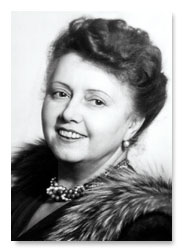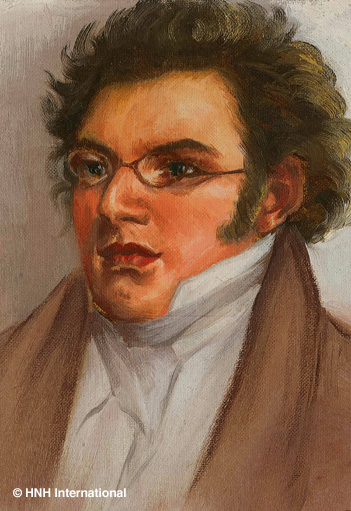
Elisabeth Schumann’s parents were extremely musical: her father was a cathedral organist and music teacher, while her mother, although untrained as singer, took part in local choral concerts. It was soon clear that their daughter possessed an attractive voice and considerable musicality, on which her father built with tuition in piano and music theory. Her first operatic experience, a performance of Tannhäuser when she was seven years old, held her spellbound and thenceforth she was a frequent visitor to the opera, with or without her parents’ knowledge.
Formal singing tuition took place in Dresden with Natalie Hänisch, followed by Marie Dietrich in Berlin, where Schumann became engaged to an architecture student, Walther Puritz. In 1909 he was working in Hamburg, so while visiting him she asked the Hamburg Opera for an audition and was immediately offered a contract. Having made her debut with this company in the autumn of 1909 as the Shepherd Boy / Tannhäuser, Schumann became extremely popular because of the natural quality of her singing. With the help of her teacher in Hamburg, Alma Schadow, she soon took on such roles as Cherubino / Le nozze di Figaro, followed by Susanna in the same opera, Ännchen / Der Freischütz and the title part in Mignon. Her real breakthrough part was as Sophie / Der Rosenkavalier, which she sang at the opera’s Hamburg premiere in 1911: it was to remain a signature role for the rest of her operatic career.
During the following year Schumann created the part of Albertine in Busoni’s Die Brautwahl and, although having married Puritz, eloped for a short while with Otto Klemperer, then a conductor at the Hamburg Opera. Despite this hiatus her reputation was sufficiently strong for her to be invited to make her debut at the Metropolitan Opera, New York as Sophie in the autumn of 1914, after which she swiftly appeared as Musetta / La Bohème, Papagena / Die Zauberflöte, Gretel / Hänsel und Gretel, Marzelline / Fidelio, a Flower Maiden / Parsifal, the Woodbird / Siegfried, Wellgunde / Das Rheingold and Götterdämmerung and Gerhilde / Die Walküre. Schumann did not, however, return to the Met after the close of the 1914–1915 season.
Following her return to Hamburg, in 1918 she divorced her first husband and the following year married the conductor Karl Alwin, who encouraged her ambitions. With her contract at Hamburg ending in 1919, she was swiftly offered a contract with the Vienna State Opera by Richard Strauss, then joint musical director with Franz Schalk, even though she had been unable to give the normally obligatory guest performance to show what she could do. After she had moved to Vienna, making her debut as Sophie followed by Micaëla / Carmen, she was soon joined by Alwin who was also to establish a good career there. Her period with the Vienna State Opera, which lasted formally until 1938 (although she appeared for what was in fact the last time there in 1937 as a Flower Maiden in Parsifal), was the most productive of her career, in that she consolidated her standing both as one the finest singers of her generation in her particular fach, and as an exceptionally fine singer of lieder and operetta. Among the highlights of Schumann’s Viennese career was her participation in Strauss’s reworking of Idomeneo in 1931. She was made not only an Honorary Member of the Vienna State Opera but also became the first woman to be an Honorary Member of the Vienna Philharmonic Orchestra.
Schumann sang frequently at the Salzburg Festival: as Despina / Così fan tutte (1922, 1936), Susanna (1922, 1936), Blonde / Die Entführung aus dem Serail (1922), Serpina / La serva padrona (1926) and Zerlina / Don Giovanni and Marzelline (1927). Encouraged by Alwin, she began to tour widely, including to the USA with Richard Strauss in 1921 and later to Italy, Spain, Romania, Hungary, Greece, Germany, France, North Africa and Argentina.
At the Royal Opera House in London Schumann first sang in 1924, as Sophie. She immediately became extremely popular with English audiences, returning regularly until 1931 to sing her Mozart roles, as well as Eva / Die Meistersinger von Nürnberg and, with especial success, Adele / Die Fledermaus in 1930 with Bruno Walter conducting. King George V and Queen Mary, attending their first German-language opera since the end of the 1914–1918 war, so enjoyed the production that they asked for a repeat performance.
In 1932 Schumann became romantically involved with a dermatologist, Dr Hans Krüger. On the day of the Anschluss in 1938, when Germany and the Nazi government annexed Austria, she left Vienna for a teaching appointment at the Curtis Institute in the USA and a tour of France and North Africa. She managed to extract Krüger (who was Jewish) from Austria and after her divorce from Alwin they were married in England and then emigrated to the USA – but divorce followed in 1944.
In America during World War II Schumann sang very little, giving just a handful of recitals and concentrating upon teaching. Her pupils included the soprano Claire Watson. After the end of the war, she returned to Europe in the autumn of 1945 to give recitals, and planned to make her home in England. Sadly she died unexpectedly in New York before being able to do so.
Schumann possessed a high soprano voice of great sweetness and purity. On stage she evidently emanated charm and when required, good-natured humour, qualities which also exemplified her singing. She recorded extensively, predominantly for the HMV label.
© Naxos Rights International Ltd. — David Patmore (A–Z of Singers, Naxos 8.558097-100).

The son of a schoolmaster who had settled in Vienna, Franz Schubert was educated as a chorister of the imperial court chapel. He later qualified as a schoolteacher, briefly and thereafter intermittently joining his father in the classroom. He spent his life largely in Vienna, enjoying the company of friends but never holding any position in the musical establishment or attracting the kind of patronage that Beethoven had 20 years earlier. His final years were clouded by illness as the result of a syphilitic infection, and he died aged 31, leaving much unfinished. His gifts had been most notably expressed in song, his talent for melody always evident in his other compositions. Schubert’s compositions are generally numbered according to the Deutsch catalogue, with the letter D.
Stage Works
Schubert wrote operas, Singspiel and incidental music for the theatre. His best-known compositions of this kind include the music for the unsuccessful play Rosamunde, Fürstin von Zypern (‘Rosamunde, Princess of Cyprus’), mounted at the Theater an der Wien in December 1823. The ballet music and entracte from Rosamunde are particularly well-known.
Church Music
Among the various works Schubert wrote for church use, particular mention may be made of the second of his six complete settings of the Mass. He completed his final setting of the Mass in the last year of his life, and it was first performed the following year.
Choral and Vocal Music
Schubert wrote for mixed voices, male voices and female voices, but by far the most famous of his vocal compositions are the 500 or so songs—settings of verses ranging from Shakespeare to his friends and contemporaries. His song cycles published in his lifetime are Die schöne Müllerin (‘The Fair Maid of the Mill’) and Die Winterreise (‘The Winter Journey’), while Schwanengesang (‘Swan Song’) was compiled by a publisher after the composer’s early death. Many songs by Schubert are very familiar, including ‘Der Erlkönig’(‘The Erlking’), the ‘Mignon’songs from Goethe and the seven songs based on The Lady of the Lake by Sir Walter Scott.
Orchestral Music
The ‘Unfinished’ Symphony of Schubert was written in 1822, but no complete addition was made to the two movements of the work. Other symphonies of the eight more or less completed include the ‘Great’ C major Symphony and the Classical and charming Fifth Symphony. His various overtures include two ‘in the Italian style’.
Chamber Music
Of Schubert’s various string quartets the Quartet in A minor, with its variations on the well-known Rosamunde theme and the Quartet in D minor ‘Death and the Maiden’, with variations on the song of that name, are the most familiar. The Piano Quintet, ‘Die Forelle’ (‘The Trout’), includes a movement of variations on that song, while the great C major String Quintet of 1828 is of unsurpassable beauty. The two piano trios and the single-movement Notturno date from the same year. Schubert’s Octet for clarinet, horn, bassoon, two violins, viola, cello and double bass was written early in 1824. To the violin sonatas (sonatinas) of 1816 may be added the more ambitious ‘Duo’ Sonata for violin and piano, D. 574, of the following year and the Fantasy, D. 934, published in 1828, the year of Schubert’s death. The ‘Arpeggione’ Sonata was written for a newly devised and soon obsolete stringed instrument, the arpeggione. It now provides additional repertoire for the cello or viola.
Piano Music
Schubert’s compositions for piano include a number of sonatas, some left unfinished, as well as the Wanderer Fantasy and two sets of impromptus, D. 899 and D. 935. He also wrote a number of dances for piano—waltzes, Ländler and German dances. His music for piano duet includes a Divertissement à l’hongroise, marches and polonaises largely written for daughters of a member of the Esterházy family, for whom he was for a time employed as a private teacher.






























